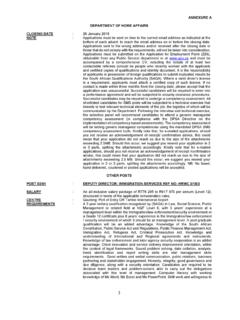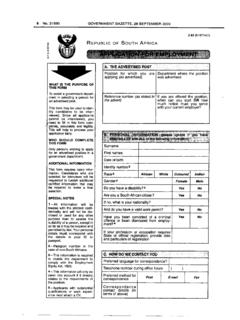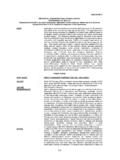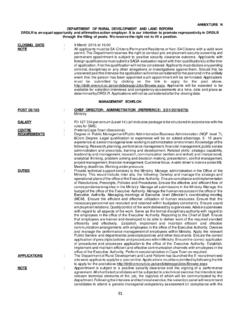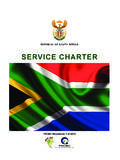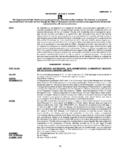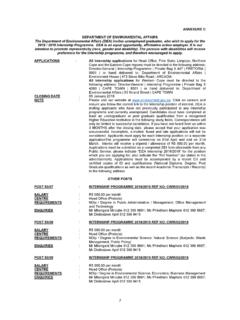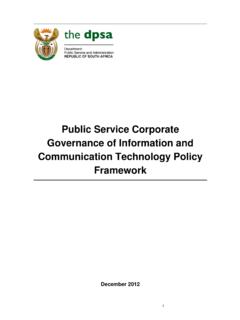Transcription of GUIDE ON DEVELOPING SERVICE STANDARDS - the dpsa
1 GUIDE ON DEVELOPING SERVICE STANDARDS . Contents 1. Background .. 3. 2. Why the GUIDE / Toolkit?.. 4. 3. SERVICE Delivery Planning Value Chain Components .. 4. 4. Definition and types of SERVICE STANDARDS .. 5. 5. Guidelines for setting STANDARDS .. 6. 6. Step-by step GUIDE to setting SERVICE STANDARDS .. 7. 7. Set STANDARDS .. 7. Empower 10. Manage STANDARDS .. 10. Communicate and Reward .. 10. Conclusion .. 10. Templates .. 11. References .. 12. Page 2 of 12 DPSA - Toolkit on SERVICE STANDARDS October 2011. 1. Background Government Departments, as SERVICE providers, have both a legal and moral responsibility to deliver the best possible services to the public. The legal responsibility emanates from a Regulatory Framework.
2 The moral aspect is underpinned, amongst others, by the eight principles of Batho Pele. Within the context of Batho Pele, providing quality services means putting in place a SERVICE delivery system that meets the needs of the people it serves. The Delivery Agreement for Outcome 12 stipulates a number of Outputs and Sub-outputs. In Output 3, Sub-output 8: Business Processes, it is stated that: it was realized during the roll out of SERVICE Delivery Improvement Plans by the DPSA that departments do not understand the value chain regarding the setting and improvement of SERVICE STANDARDS . Undocumented processes means that staff turnover can compromise SERVICE delivery, and that consistent quality STANDARDS are difficult to maintain.
3 A further complicating factor is that where mapping of processes is being conducted, it does not take place within a nationally set norm and standard and also outside of any set framework regarding the value chain dealing with SERVICE delivery improvement. One of the Key activities outlined to address the above is: Development of a framework and toolkit for: i. Business Process Mapping, review and management ii. Standard Operating Procedures (SOPs). iii. Setting of SERVICE STANDARDS ; and iv. SERVICE Delivery Improvement Plans (SDIPs). This link between Business process mapping, SOPs, Setting of SERVICE STANDARDS and SDIPs is furthermore stressed within the Outcome 12 Delivery Agreement which states (p65) that: The MPSA thus has limited powers directly over the efficient and effective running of a department except his own, but he can set norms and STANDARDS within which parameters other executing authorities must operate.
4 These norms and STANDARDS then set minimum requirements to which a department must adhere the MPSA. can monitor compliance and share best practice amongst departments. There is a need for DPSA to initiate and lead a coordinated approach in the setting of SERVICE norms and STANDARDS . This GUIDE is to serve as a generic and practical toolkit to the consultation, design and documentation of SERVICE norms and STANDARDS . Sector-/ line Departments have unique challenges (eg. Large geographic SERVICE areas, inequalities in terms of income, access to transport/. infrastructure, etc. departments also have varying capabilities in dealing with these challenges and in managing SERVICE STANDARDS . The bottom line is that all Departments have a responsibility to review, improve and report on SERVICE STANDARDS .)
5 Page 3 of 12 DPSA - Toolkit on SERVICE STANDARDS October 2011. 2. Why the GUIDE / Toolkit? The White Paper on Transforming Public SERVICE Delivery (Batho Pele White Paper, 1997) provides a clear mandate to departments on the setting of SERVICE STANDARDS : National and provincial departments must publish STANDARDS for the level and quality of services they will provide, including the introduction of new services to those who have previously been denied access to them. In the case of certain services , such as health, or education, national departments, in consultation with provincial departments, may set STANDARDS which will serve as national baseline STANDARDS . Individual provinces may then set their own STANDARDS , provided these meet or exceed the national baseline.
6 Provincial departments may also set additional STANDARDS for aspects of SERVICE not covered by national norms. Similarly, departments may set intra-departmental SERVICE STANDARDS which will serve as minimum norms for their institutions and components. These internal institutions and components may also set additional SERVICE STANDARDS for aspects not covered by intra-departmental norms. STANDARDS must also be precise and measurable, so, that users can judge for themselves whether or not they are receiving what was promised. SERVICE STANDARDS must be set at a level which is demanding but realistic. SERVICE STANDARDS must have the approval of the relevant Minister/MEC/ executing authority before they are adopted.
7 Once approved, SERVICE STANDARDS must be published and displayed at the point of delivery and communicated as widely as possible to all potential users so that they know what level of SERVICE they are entitled to expect, and can complain if they do not receive it. Performance against STANDARDS must be regularly measured and the results published at least once a year, and more frequently where appropriate. Performance against STANDARDS must be reviewed annually and, as STANDARDS are met, so they should be progressively raised, year on year. Once set and published, STANDARDS may not be reduced. If a standard is not met, the reasons must be explained publicly and a new target date set for when it will be achieved.
8 Departments have succeeded in varying measures in delivering on the above mandate. Unfortunately, due to the lack of a systemic approach, departments have often done their own thing, sharing with other departments did not take place and duplication of efforts occurred. This GUIDE is only one link in a set of guidelines on SOPs, Business process management and SDIPs, all aimed at harnessing the collective knowledge of the Public SERVICE in achieving more efficiency and effectiveness when it comes to SERVICE delivery. 3. SERVICE Delivery Planning Value Chain Components The concept of Value Chain was first described and popularized by Michael Porter in the 1980's. By definition, a value chain categorizes the value-adding activities of an organization.
9 The chain of activities gives the services more added value than the sum of the independent activity's value. Below is a schematic representation of the SERVICE delivery planning value chain. The setting of SERVICE STANDARDS is a key deliverable for the drafting of quality SERVICE charters and SERVICE delivery improvement plans. Page 4 of 12 DPSA - Toolkit on SERVICE STANDARDS October 2011. Figure 1. 1. Strategic Planning 2. Develop SERVICE Delivery Model 3. Business Process Management 4. Standard operating procedures 5. Unit Costing 6. SERVICE STANDARDS 7. SERVICE charters 8. SERVICE delivery improvement plans The concept of SERVICE STANDARDS is fundamental to the first pillar of the DPSA SERVICE Delivery and Organisational Development (SDOT) framework.
10 A framework and methodology for the development of SERVICE STANDARDS was developed and approved during the first half of 2011. The approach outlined in this document is intended to be a toolkit aimed at assisting Departments to follow a systematic and standardized approach in STANDARDS setting. 4. Definition and types of SERVICE STANDARDS A standard is a basis of measurement and a definite level of excellence . A Departmental SERVICE standard is something desired (by the Department and citizens) and achievable. A Norm', on the other hand, is defined as a usual or average level of performance . A SERVICE standard is a reasonable and measurable expectation from the side of the recipient, and an honest commitment by the SERVICE provider, to meet or exceed that expectation.
